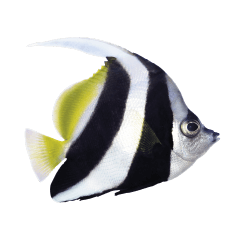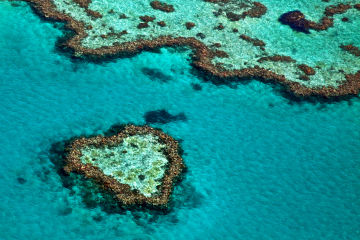News ·
5 Reef stories of hope you may have missed in 2024
Last year, the Great Barrier Reef faced devastating challenges but we also saw a groundswell of action and research to help protect this national treasure.

In 2024, the Great Barrier Reef suffered the worst summer on record, enduring cyclones, severe flooding, crown-of-thorns starfish outbreaks and a mass coral bleaching event.
As reports of increasingly frequent and severe bleaching events emerge, you could be forgiven for thinking it's too late to protect coral reefs. But we've made more advances in coral reef science in the last five years than has been made in the past 50. With our partners, donors, and supporters, we're breaking through scientific and engineering barriers and pioneering solutions for Reef resilience.
Here are some of the exciting developments from 2024 that give us hope for a better future for coral reefs:
#1. Technology to protect baby corals
Coral researchers have been collaborating with marine and aquaculture engineers to design cradle-like devices that can improve baby corals' odds of survival, and safely house newly settled corals after they’ve been planted on the Reef.
During coral spawning in November, coral babies were encouraged to settle on these devices and for the first time, deployed on to the Reef to research their growth and survival. This was achieved as part of a process called Coral IVF where the cradle-like devices were placed into floating larval pools with coral spawn slick collected from the ocean surface. Once the spawn develops into coral babies, these tiny coral recruits can find a safe home on these devices in which to attach.
#2. Cryo-born coral babies deployed for the first time on the Great Barrier Reef
During the October coral spawning event on the Great Barrier Reef, reproductive biologists from Taronga Conservation Society Australia used cutting-edge cryopreservation techniques to successfully fertilise fresh coral eggs using cryopreserved coral sperm.
Working alongside researchers from the Australian Institute of Marine Science in the world’s most advanced research aquarium – the National Sea Simulator – they were able to collect fresh eggs from corals spawning in the lab to conduct this research.
Now, these cryo-born coral babies have been delivered into their natural habitat, the Great Barrier Reef, on coral cradles so researchers can track how well they grow in their critical first year of life.
#3. World's largest seagrass nursery unveiled to supercharge restoration
Seagrass meadows provide nurseries and feeding grounds for many marine species, improve coastal water quality, increase biodiversity on land and in the water and enhance the resilience of coastal habitats in the face of climate change. These critical habitats are also under threat due to land-based pollution and the impacts of climate change, particularly the increasing severity of storms, causing extensive losses of seagrass meadows.
Restoration of Great Barrier Reef meadows will be significantly boosted thanks to the world’s largest purpose-built seagrass restoration nursery which was unveiled in Gladstone in November.
CQUniversity’s SeaGrow nursery is funded by the partnership between the Great Barrier Reef Foundation and Coles Group and is the world’s first large-scale seagrass nursery that has been developed with leading seagrass researchers and Reef Traditional Owners.
This new expanded seagrass nursery will see restoration scaled up significantly using an innovative seed-based method pioneered at the facility, to help repair critical ecosystems whilst unlocking the Great Barrier Reef’s potential to mitigate the impacts of climate change.
#4. Less COTS, more coral
Crown-of-thorns starfish (COTS) are a significant threat to our Great Barrier Reef. While they are a native species, they eat large quantities of coral and can cause irreparable damage to our Reef if left unchecked.
Through years of research and development, the COTS Control Program is guided by cutting-edge science, data and modelling to deliver a remarkably simple and effective hands-on solution – targeted culling.
The program’s achievements were summarised in a scientific article that demonstrated how this approach is making a real difference to coral reef health.
The study, led by the Reef Authority in collaboration with research and delivery partners, demonstrated up to a six-fold reduction in starfish numbers and a 44% increase in coral cover across regions that received timely and sufficient control effort.
By manually culling COTS, the COTS control team is reducing the number of coral-eating starfish to levels that support coral growth and recovery.

News ·
Less COTS, more corals
#5. Championing Traditional Owner co-design for vital reef fish monitoring
Reef fish are vital to the health of coral reefs. Over 1,500 fish species call the Great Barrier Reef home, and their lives are intricately intertwined with the rest of their reef ecosystems.
Monitoring reef fish supports reef management and helps stakeholders understand how a wide range of factors may impact reef fish populations and the critical functions that reef fishes perform.
As part of the Reef Trust Partnership’s Integrated Monitoring and Reporting (IMR) program, the Foundation funded the Australian Institute of Marine Science (AIMS), along with collaborators from University of the Sunshine Coast, TropWATER at James Cook University, Indigenous Rangers and Traditional Owners to monitor reef fish populations across the Reef.
What makes this project unique and impactful has been the co-development of the nursery seascape component, by partnering on Sea Country with Manbarra, Wulgurukaba, Djiru, Gulngay, Girramay, Bandjin, Warrgamay and Nywaigi Traditional Owners and Girringun Aboriginal Corporation. The project achieved this through adoption of the AIMS Indigenous Partnerships Program framework.
The Traditional Owners of the Reef have been custodians of their Sea Country for millennia, carrying out their inherent rights and responsibilities to care for Country. As knowledge has been passed down from generation to generation, today’s First Nations Peoples of the Reef hold an immense accumulated wisdom, which the IMR reef fish project has been fortunate to learn from.








